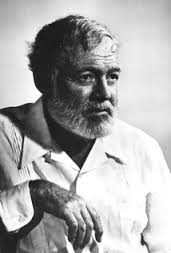
Ernest Hemingway (July 21, 1899 – July 2, 1961) was an American writer and journa-list. His style of writing had a strong influence on 20th-century fiction, while his life of adventure and his public image influenced later generations.
In 1954 received Hemingway the Nobel Prize in Literature. He modestly told the press that Isak Dinesen and Bernard Berenson deserved the prize, but he gladly accepted the prize money. Mellow claims Hemingway “had coveted the Nobel Prize”, but when he won it, months after his plane accidents and the ensuing world-wide press coverage, “there must have been a lingering suspicion in Hemingway’s mind that his obituary notices had played a part in the academy’s decision.” Because he was suffering pain from accidents he had in Africa, he decided against traveling to Stockholm. Instead he sent a speech to be read, defining the writer’s life:
“Writing, at its best, is a lonely life. Organizations for writers palliate the writer’s loneliness but I doubt if they improve his writing. He grows in public stature as he sheds his loneliness and often his work deteriorates. For he does his work alone and if he is a good enough writer he must face eternity, or the lack of it, each day.”
Hemingway produced most of his work between the mid-1920s and the mid-1950s. He published seven novels, six short story collections, and two non-fiction works. Additional works, including three novels, four short story collections, and three non-fiction works, were published posthumously. Many of his works are considered classics of American literature.
Hemingway was raised in Oak Park, Illinois. After high school, he reported for a few months for The Kansas City Star, before leaving for the Italian front to enlist with the World War I ambulance drivers. In 1918, he was seriously wounded and returned home. His wartime experiences formed the basis for his novel A Farewell to Arms (1929).
In 1921, he married Hadley Richardson, the first of his four wives. The couple moved to Paris, where he worked as a foreign correspondent and fell under the influence of the modernist writers and artists of the 1920s “Lost Generation” expatriate community. He published his first novel, The Sun Also Rises, in 1926. After his 1927 divorce from Hadley Richardson, Hemingway married Pauline Pfeiffer; they divorced after he returned from the Spanish Civil War where he had been a journalist, and after which he wrote For Whom the Bell Tolls (1940). Martha Gellhorn became his third wife in 1940; they separated when he met Mary Welsh in London during World War II. He was present at the Normandy landingsand the liberation of Paris.
Shortly after the publication of The Old Man and the Sea (1952), Hemingway went on safari to Africa, where he was almost killed in two successive plane crashes that left him in pain or ill health for much of his remaining life. Hemingway maintained permanent residences in Key West, Florida, (1930s) and Cuba (1940s and 1950s), and in 1959, he bought a house in Ketchum, Idaho, where he committed suicide in the summer of 1961.
Following the November 2015 Paris attacks, Hemingway’s memoir A Moveable Feast became a bestseller again in France. Sales of the book (first published posthumously in 1964) surged in French bookstores, and numerous copies were placed by Parisians among the flowers and candles at the many makeshift memorials that sprang up across the city honoring victims of the attacks.
